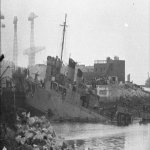"THE AIR Bridge
In 1975 the TAP fleet was involved in one of the largest repatriation operations in the history of aviation. During several months dozens of crews from Boeing 747 and 707 made real prodigies(wonders) to remove from Angola (and Mozambique also) hundreds of thousands of refugees escaping the hasty independence of those new countries and civil wars that were now declared themselves.
It was worth everything. Crews were working 26 consecutive hours, resting the drops when circumstances allowed. Overweight? Who cared about this?
The Boeing 747 had 350 spots but rarely walked with less than 400 souls on board. The B707s also ′′ stretched ′′ as they could. It was to come in while there was space and close the doors as soon as possible.
Aircraft crowding was often exceeded and most of the rules and procedures were on stand by; lives were to be saved, everything else didn't matter.
As if all this effort wasn't enough, the crew members lived live live the dramas of thousands of families who lost everything they had conquered in their lives and headed now to a country that few knew and would only have hardly conditions to receive them.
I did not participate in this operation, adequately known as the Air Bridge. At the time it flew Boeing 727, a plane that had no autonomy to reach Luanda or anything that looked like it, but every day I found hundreds of people in the airport rooms. They piled up on bags and bins while waiting for someone to get them a place to stay. I only saw looks of disbelief around me. How was this even possible?
Seven hundred homeless people a day and sometimes more than a thousand. Lisbon airport was transformed into a large refugee camp, only with less conditions than the real refugee camps. An immense tragedy unfolded in front of our eyes and we could do little or nothing.
The story of this Air Bridge has never been told in its true dimension. The drama of the refugees and the heroism of those who saved them from certain death will one day be revealed to the Portuguese in all their crueza(rawness) and without any complexes.
Yes, TAP then responded to the call without looking at sacrifices and will respond back whenever necessary."
Afghanistan reminded me.




















































































